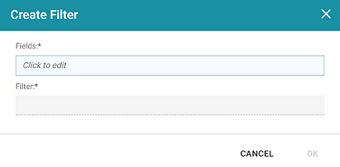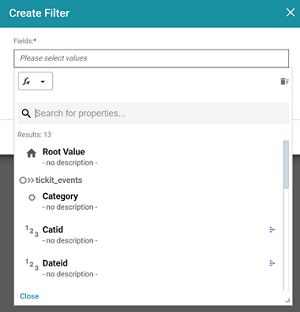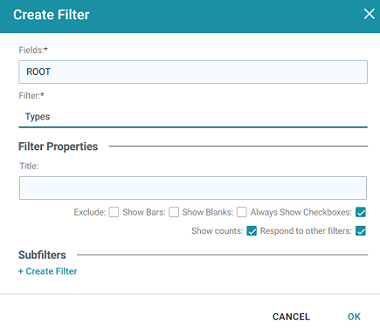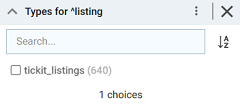Adding a Types Filter
Types filters are used to filter data according to the types of data (classes) that are connected by a specified path. This type of filter is available only for paths and not properties. Follow the instructions below to create a types filter.
- Open the dashboard that you want to add the filter to.
- In the Hi-Res Analytics main toolbar, click Filters and select Create a Filter. The Create Filter dialog box is displayed.

- Click in the Fields field to open the property drop-down list and determine the path to filter on. The list of available classes, paths, and properties depends on the selected data type for the dashboard.
For example, the following image shows the list of properties that are available for a dashboard whose source is a graphmart that contains data about tickets sold for various types of events. The type for the dashboard is
tickit_events:
The list below describes the icons and options that are available when choosing a path:
- The Root Value (
 ) is the instance URI for the root resource—the URI for the instances of the class that was chosen as the data type for the dashboard.
) is the instance URI for the root resource—the URI for the instances of the class that was chosen as the data type for the dashboard. To view the root values, you can use the STR function to show a string representation of the URIs.
- Linked classes are represented by incoming (
 ) and outgoing (
) and outgoing ( ) connection icons. The properties in those classes with a path to another class are denoted with a circle icon (
) connection icons. The properties in those classes with a path to another class are denoted with a circle icon ( ). Selecting a linked property navigates to that class and displays its properties.
). Selecting a linked property navigates to that class and displays its properties. - When a property or path is selected, the breadcrumbs at the top of the dialog box show you the property path. You can click the clear icon (
 ) to clear the path and start again or you can click the forward (
) to clear the path and start again or you can click the forward ( ) or back (
) or back ( ) arrows to go forward or backward one or more levels at a time.
) arrows to go forward or backward one or more levels at a time. - After you have selected a path, you can apply a function or formula to calculate the values that are displayed in the filter. To add a function, click the function button (fx) at the top of the drop-down list. The functions that become available depend on the data type of the selected path. To choose a more advanced function or type a formula, click Advanced. The Calculated Value dialog box opens and enables you to choose additional properties and functions. For more information, see Calculating Values in Lenses and Filters.
- The Root Value (
- After you have selected the path to filter on, click Close to close the Fields drop-down list.
- Next, click the Filter field and select Types from the drop-down list. The dialog box is refreshed to show the Filter Properties and other options that are available for the filter type:

- Configure any of the following properties. All of the fields are optional:
- Title: Defines the title that appears at the top of the filter when it is added to the dashboard. If Title is blank, the Fields value is used as the title.
- Exclude: This setting controls whether selecting a value in the filter narrows the results to show only the records that include that value or whether selecting a value excludes the records that include that value. When Exclude is disabled, selecting a value in the filter narrows the dashboard results to show only the records that include that value. When Exclude is enabled, selecting a value filters out all of the records that include that value.
- Show Bars: This setting controls whether the total values for the selected property appear as a bar graphic in the background of the filter.
- Show Blanks: This setting controls whether to include null values for the selected property by listing them as Blank in the filter.
- Always Show Checkboxes: This setting controls whether checkboxes are shown next to the items in the filter.
- Show Counts: This setting controls whether the number of results for each filter value are displayed in parentheses next to the value.
- Respond to Other Filters: This setting controls whether the results of this filter change based on the selections made in other filters on the dashboard.
- If you would like to be able to further constrain the data that appears in the filter, you can add one or more subfilters. To add a subfilter, click Create Filter under Subfilters. The process of creating a subfilter is the same as the process for the parent filter. However, the subfilter is not displayed on the dashboard. It is visible only when editing the parent filter, and the subfilter's configuration affects only the parent filter and any sibling subfilters.
- When you have finished configuring the filter, click OK to add it to the dashboard. The new filter appears in the left pane of the dashboard and displays the values that are available for filtering the displayed data.
For example, the filter in the image below shows that there is one type of class of data that is connected by the chosen path.

Depending on whether the Exclude option is enabled or disabled, selecting an item in the filter refreshes the dashboard to show only the data includes the selected value or only the data that does not include the selected value.
When working with the filter on the dashboard, the following options are available for sorting and configuration:
- Search: Enables you to search for a value in the filter. The search is case-insensitive.
- Sort (
 ): Shows the following options for sorting the results in the filter:
): Shows the following options for sorting the results in the filter:- Count Ascending: Orders results from the smallest count to the largest.
- Count Descending: Orders results from the largest count to the smallest.
- Name Ascending: Orders results in alphabetical order.
- Name Descending: Orders results in reverse alphabetical order.
- show/hide filters: This option is displayed when a value is selected. It shows or hides the selection.
- Menu (
 ): The menu contains the following options:
): The menu contains the following options:- Select All Visible: This option selects all of the items that are listed in the filter.
- Clear: This option is available when one or more items are selected. Clicking Clear removes the selections.
- Designer: Selecting this option opens the designer so that you can view or change the filter configuration.
- Close (X): Clicking X deletes the filter from the dashboard. This action cannot be undone.